The 2008 National Hill climb Championship took place on Bank Road, Matlock.
- Distance: 830m
- Average gradient of 14%.
- Maximum Gradient of 20%.
- Weather was good for late October. Sunny and dry. There was a full field of 150 riders.
Today was another two-stage hill climb, organised by Solihull CC on Dover’s Edge and Saintbury. Both climbs have been venues for the national hill climb championship in previous years. I have done this two-stage combination in 2008, 2010 and 2011. So after a gap of nine years, it was back to Weston on the Edge.
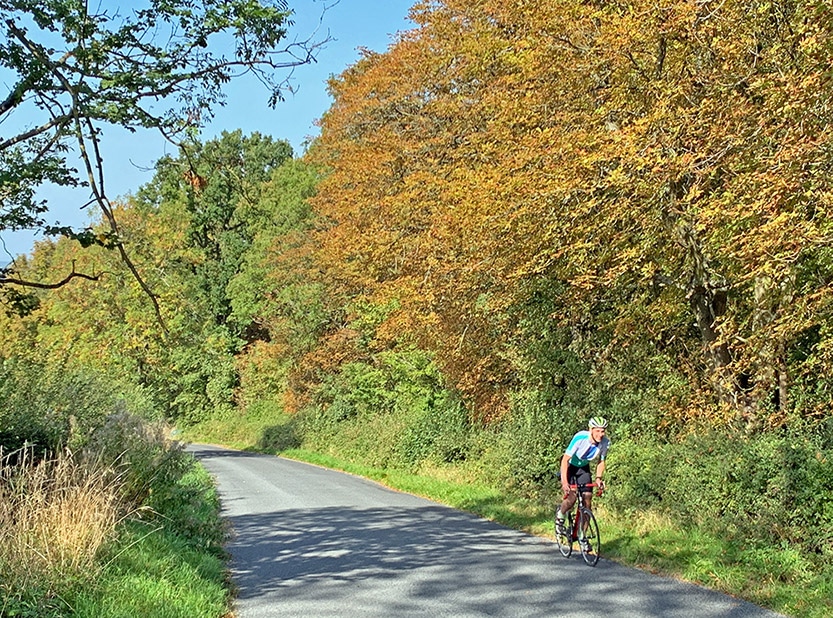
At this time of the year, it is an attractive part of the world, especially in autumn. Back in the day, I could just about ride out here from Oxford, making a good 100 mile round trip. But, I haven’t done that kind of mileage for a long time.
The weather was very good, by the second climb, it felt quite hot. There was a fairly helpful tailwind up both climbs.
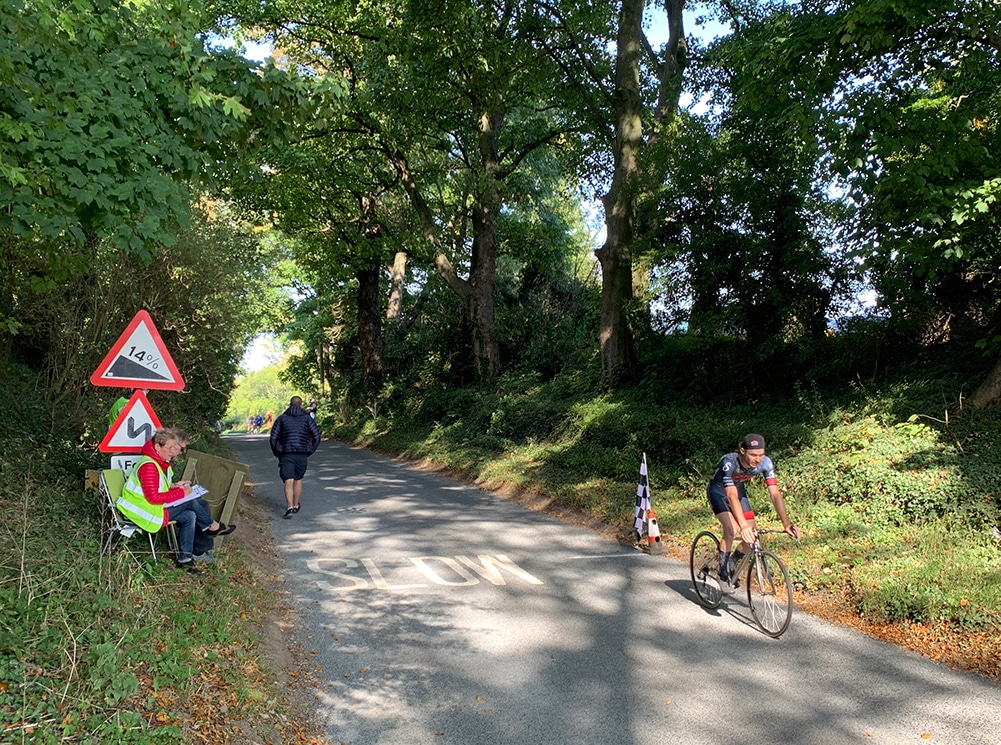
Saintbury is the longer of the two climbs. There is a steeper section near the bottom and then it keeps dragging up. I went quite hard on the steep bit and perhaps paid for it a little bit towards the end.
Today was the double-header Snap Hill climb organised by Swindon RC. The first climb is a long 3 mile drag. The second climb – is the short and sharp – Snap hill climb in the opposite direction. With many events falling by the wayside this year, there was a bumper entry with over 50 riders entered. It was also perfect weather with 18 degrees, a light westerly wind and a sunny day. There were quite a few cars on the road though, maybe due to tailbacks on the M4.

From my own perspective, it is something of a comeback ride. The last race I did was over 3 years ago, and it is July 2016, since I entered a race without any injury problem. That last race was the National 12 hour TT in Wales, fortunately, this was a very different kettle of fish. As far as re-introduction to the hill climb season goes, Aldbourne Long drag – 3 miles @2.3% is a fairly welcome entry point. I have done the climb before in 2012 and 2014, and have decided on using TT bike as best equipment.
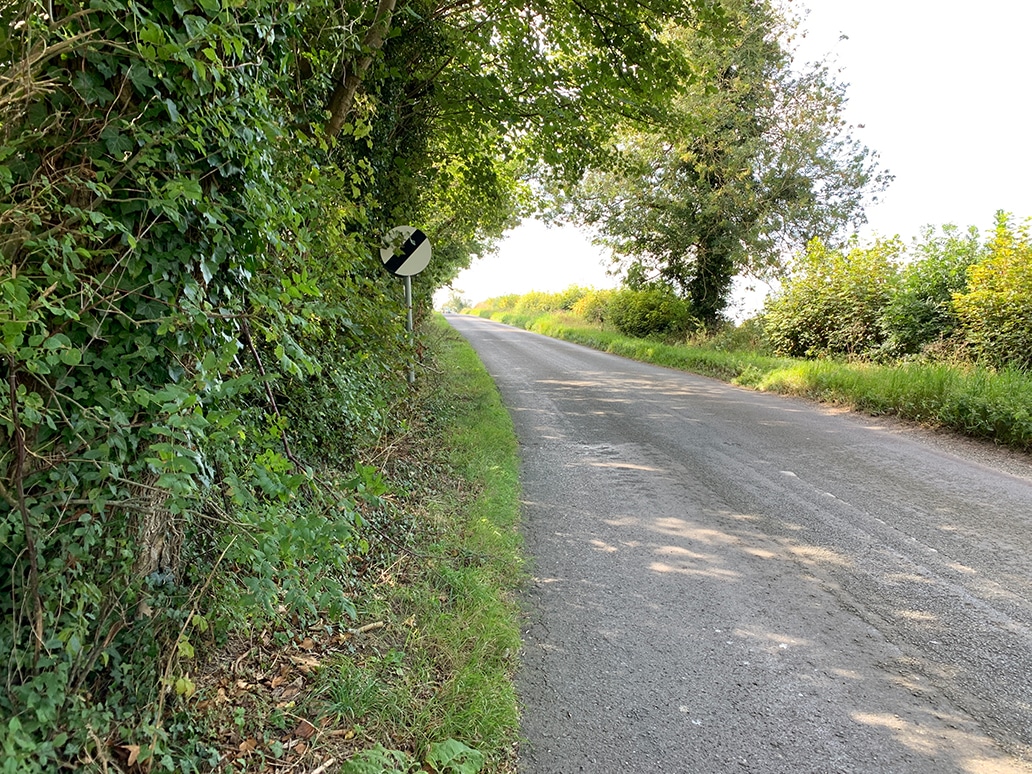
I started with the bike on the big ring (56″) but kind of regretted it because the start was much harder than I remember. Just after the start is the steepest section and there seemed to be quite a strong headwind. I had memories (perhaps misplaced) of floating up this climb with big cadence and fast speed, but today it seemed hard work and slow. Maybe it’s not the climb that has changed but the rider! As the climb nears the top, there is a nice bit of fast downhill before the final run to the line.
Recently I have been riding a few time trial efforts. Using my TT bike (though with none of the aero extras) It has been fun to redo local time trial circuits like Brill Hilly, Long Hanborough. Both these circuits I did as club events back in 2004 and 2005, but I haven’t done for many years.

The other day I was riding out to Charlbury and I saw four teenagers on bikes trying to turn right on a busy road. It was difficult for them to find a suitable gap in the traffic to turn right and after been stuck at the junction for a while, a young girl turned around to apologise to the motorist behind, saying ‘Sorry, it’s taking so long!’ The motorist perhaps surprised that anyone on a road would ever apologise, was very cheerful in replying to the girl not to worry. They were able to turn right shortly after – four young people looking like they were just getting into cycling. I hope they weren’t put off by the difficulties of turning right on Oxford’s busy roads. Anyway, it was very nice to see such consideration amongst road users.
I sped off on my TT bike and rode around Charlbury and Chipping Norton. I did quite a good effort, though was left wondering if you can average 24.7 mph on a TT bike with floppy road jersey and training wheels, what could you average with the fully optimised aero kit? This is the problem with doing time trials, as soon as you finish – you start thinking about how you could go quicker? I really am interested to find out, but at the same time, I really don’t know if I can face riding skinsuit and aero helmet for a ‘private’ time trial.
On the way, back I was still on my aero bars when on the other side of the road I saw a lady, in a wonderful full-length white dress billowing in the wind, she was also on a classic sit up and beg style bike, with back perpendicular to the road. I was on my TT bike – with back horizontal to the road. She looked like something out of Edwardian England or a Sherlock Holmes novel. I don’t know what I looked like on my aero TT bike, dried snot still on the side of the face. Anyway, I looked up from my aero tuck and said hello to the lady. She smiled and said hello back. We were like the yin and yang of the cycling world. She was enjoying the grace and dignity of cycling as a pastime. I was enjoying the aero speed of a TT bike.
I got home after a long, hard 60 miles and took a while to recover.
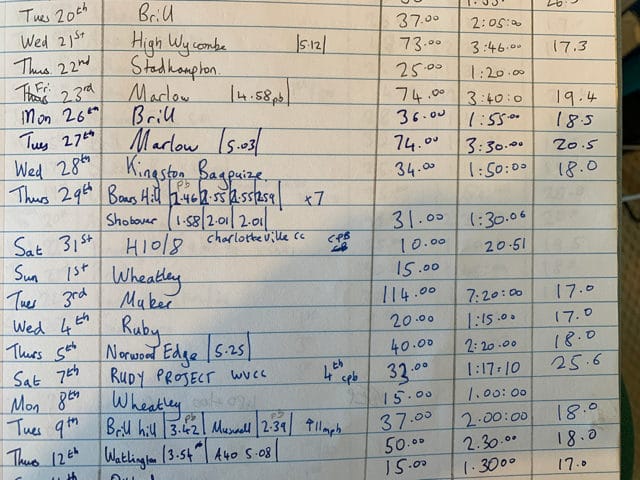
This is my training diary from 2010. In those days I still manually checked and recorded my time going up hills. You had to choose a suitable start and finish point, then manually check your time, using a lap counter. I would then write down all the hill climb times in my training diary so I could see if I got a pb. I remember many years of not having a lap counter – just the timer on a bike. So I would wait for the timer to get to an exact minute and then start the effort (sometimes soft pedalling waiting in anticipation). At the finish of the climb, you needed to do a bit of mental arithmetic 34.00 start – 36.45 finish. It was surprisingly hard work when you’ve just done a hill climb effort. To spice things up, I sometimes got bored with waiting for the minute to come around and started on 34.30. Try calculating 34.30 – 36.23 when you’ve just blown your lungs away. (and then you have to remember your time. After finishing a climb I would be repeating 5.13 like a mantra for several minutes so I didn’t forget!)
The biggest problem though with manually timing your efforts was having a consistent start and finish point, you might choose things like ‘tree to tree’ – ‘signpost to signpost’. But, when you’re doing a big effort, it was very tempting to almost unconsciously choose a different tree or different signpost. I used to often measure my efforts on Aston Hill on the A40; and after a few years, I realised my ‘hill climb course’ was getting shorter and shorter – with every year. It wasn’t a conscious decision, it was just that the mind played tricks on you, and it gave an excuse to take a different marker each time. It was one way to get a pb I suppose!
Strava and Garmin have taken all the angst out of measuring your hill climb efforts. The segment never gets shorter, and it is a very convenient way to measure hill climbs. Before Strava I probably had about 7 hills, I measured personal bests, but now with Strava, there is almost an unlimited number to compare your efforts. Because it is so easy to measure personal best times, it is fun to train on different hills. It means you can always choose a hill where there is something of a tailwind on. (no one does hill climb intervals into headwinds do they?)
The other thing about Strava, of course, is that you don’t just get personal bests (pb) but you compare against other riders too. This has its pros and cons. No matter who you are – you can guarantee at some point, someone will go faster than your pb. That is why I turn off all notifications and never read notifications on a matter of principle. If I get joy from setting a new pb, I don’t need to be told someone has gone faster.
Ever since I started cycling, that has always been the fascination of cycling – can I go faster? These days even the most marginal personal best is a huge source of satisfaction. In one sense it gets harder, but with innumerable segments there’s always something else to try.
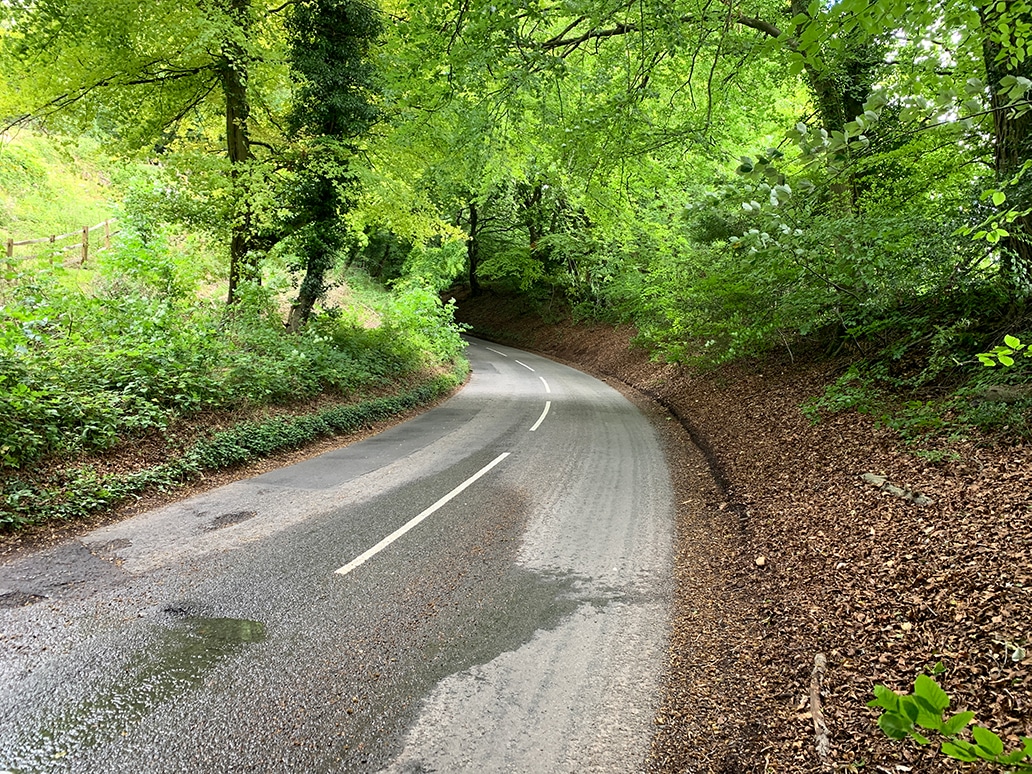
Whiteleaf Hill
Whiteleaf is one hill I never used to visit in pre Strava days, perhaps I didn’t know about it so well. It is about 20 miles from Oxford as opposed to 15 miles to Aston Hill. But for the extra five miles, you get a much steeper and better hill. The route out from Oxford to Whiteleaf is quite flat, so it is a long warm-up, a long anticipation of the big effort to come.
Since getting back into cycling in recent months, like usual, I am keen to measure how I compare to previous years so I went to measure my time up Whiteleaf. From 2015, I had a time of 4.03 for the full hill. I really wanted to see how close I could get.
Now, after four years off the bike, I have gained some weight. Approximately 0.7 kg, so it’s not exactly like I’m buying bigger trousers or people are saying ‘how’s it going fatty Pettinger?’ (62.3 kg as opposed to 61.5kg). But, if you live in the hill climb world, 0.7kg is still about one second on a hill like Whiteleaf. So at the bottom of Whiteleaf I left a water bottle at the bottom of the hill to compensate for my extra weight and then began the big effort of the day.
The first thing I noticed is that starting the climb – the expected tailwind seemed to disappear and felt like a headwind. This was meteorologically impossible, but probably the mind playing tricks on me.
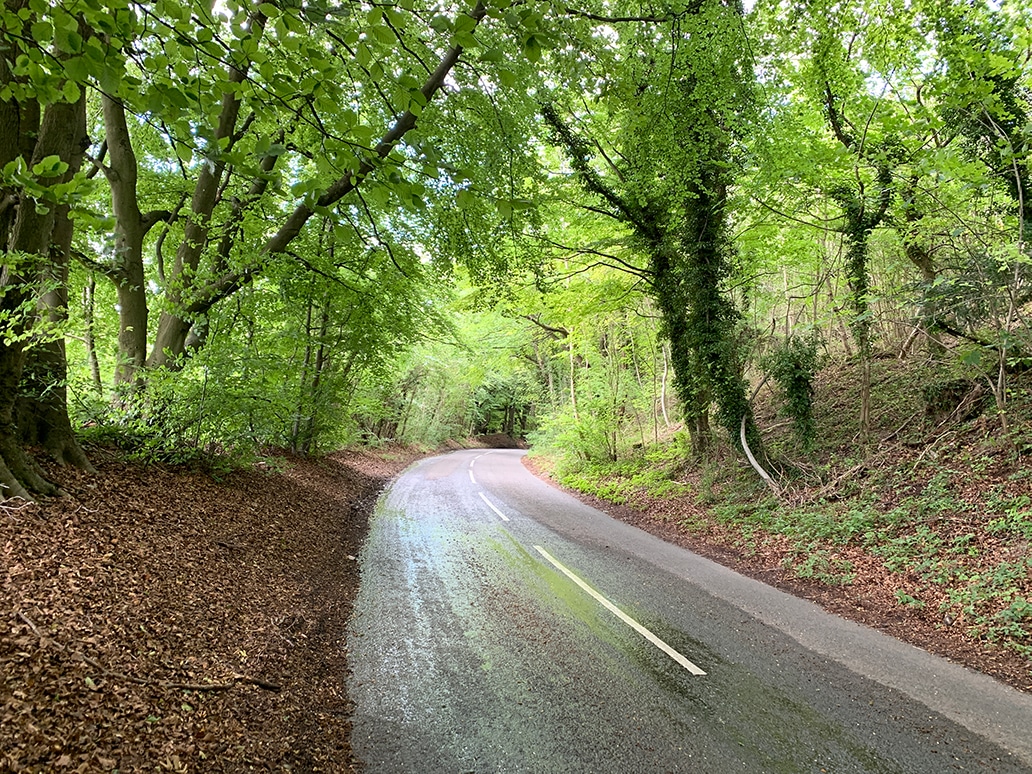
Whiteleaf is a tough hill because it is very variable gradient. There are 3 or 4 sections where it goes over 15% and you are out of the saddle pushing hard, then the gradient levels off and it’s tempting to go back into the saddle for a few seconds. But, when I did this, my momentum slipped and you were soon back out of the saddle again. Despite riding the hill many times, I’ve never quite worked out the best solution to be in the saddle or out. I would like to try again and stay out of the saddle for the whole last part of the climb. Going in and out all the time seems inefficient, but when you’re climbing that’s what I end up doing.
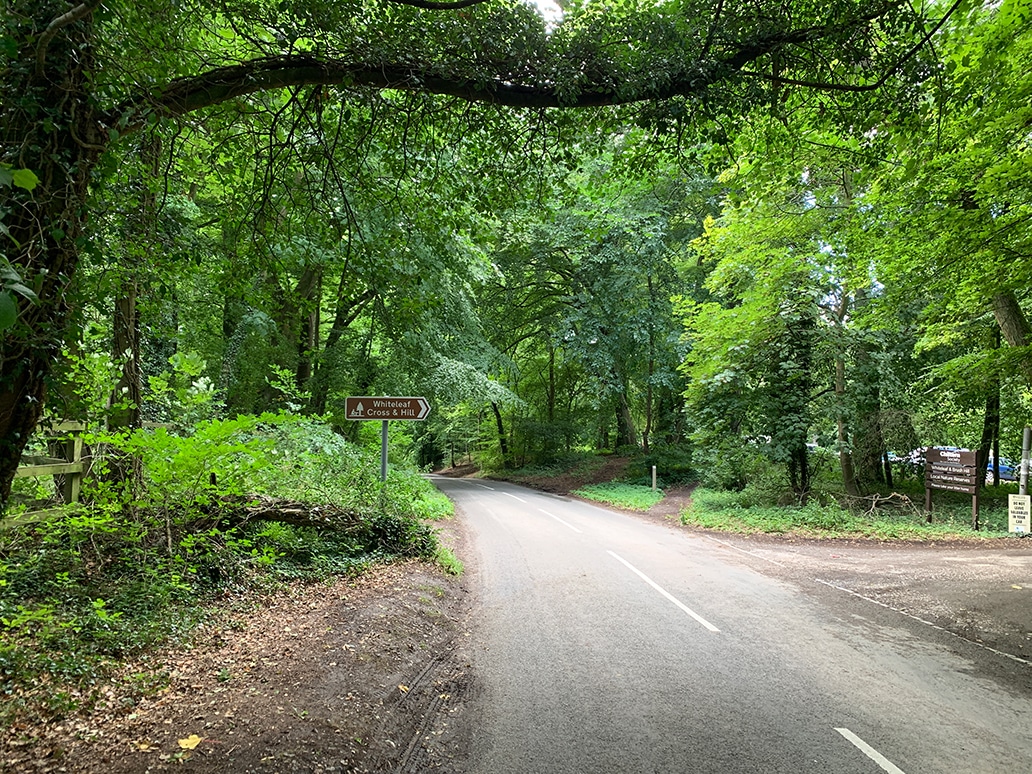
The good thing about getting to Whiteleaf is that there are plenty of other climbs in the vicinity. If you turn right at the top you go down Kop hill. So you can do a u-turn and go up Kop Hill again. Or if you turn left at the bottom of Kop hill you go up another climb called Wardrobes. On Wardrobes, there was a road closed sign which I ignored – as I was curious to know if it is OK to cycle through. The workmen stopped me for a bit and then waved me through. I would have been quite happy to turn around. But, the workman decided I can continue to climb up Wardrobes. After Wardrobes, if you take two left turns, you are soon coming back down Whiteleaf – which was convenient to pick up the water bottle I left earlier. It makes a good hilly circuit. In the past four years of non-racing I believe that there was a hilly time trial organised around Whiteleaf – I hope it is still going next year.
After that, I cycled through Chinnor (two sets of long traffic lights) which didn’t bother me as I saw it recuperation time before going up Kingston Blount. I made a good effort up Kingston Blount until traffic lights right at top of the steep part brought an unedifying conclusion to that effort. I stopped at traffic lights with heart-pumping madly. The A40 through Tetsworth is closed for 20 weeks (more closed roads) so I went back via Watlington hoping I would avoid meeting more road closed signs and traffic lights.
In the old days of measuring your own times, I would have known what time I did up Whiteleaf straight away, but this time I didn’t know until I uploaded.
4.02 – one second quicker than 2015. I knew it was a good decision to leave a water bottle at the bottom of the hill!
If power meters had never been invented I would be quite happy. They cost a lot of money and in the past two years I’ve had more technical problems with power meters than I have had with any other cycling equipment.
On the other hand, it’s hard to push back technological advances, as the Luddites found out all those years ago. Yes, it would perhaps be nice if we all rode single speed steel frames with nothing more than the wind in our face to evaluate how hard we’re trying. But I can’t deny I’d rather have a 6kg Emonda for climbing in the Lake District, and now you can have a power file to look at and muse after. Whether you get as much joy inspecting a power file as you do climbing Hardknott pass, who can say?
My power meters
Quark Elsa
The Quark Elsa is a pain to fit (at least for me – of low technical capacity) and it frequently broke down in the first six months. To be fair, it’s been quite reliable this year and the power figure seems reasonably reliable. However, a dropped chain on Monday did knock off a precariously balanced magnet, showing it’s just another thing that go wrong.
Stages
I bought a Stages power meter crank this April because I wanted one for the road bike, and it was too difficult to swap the Quark cranks / bottom brackets e.t.c. Stages is half the price of Quark and at £700 is moving into the area of reasonably affordable (by cycling standards anyway)
It is relatively easy to fit, you just need a bit of finesse with a torque wrench (something I lacked, rounded a bolt and had to buy a new bolton ebay) Since using in May, the Stages has been reliable and consistent so far.
The main thing about the Stages is that it gives a reading of 30-40 watts more than the Quark. I was really excited to suddenly be getting an extra 40 watts on training rides. Though alas, I still had very similar times to last year’s efforts at 40 watts less. An extra 40 watts means nothing, if you don’t go any faster. That’s the thing with power meters, it still is the time which counts in races (at least for now…)
I’ve tried resetting Stages, but it gives the same high power reading, which is a bit of a pain for comparing power meter outputs between the different bikes, I’m not sure which is right. For a five minute hill, it’s the difference between a watt per kg ratio of around 7.3 or 6.8.
I think there is a way of testing the reliability of power meters and properly recalibrating, but I don’t really have time.
Pacing. Perhaps the most obvious benefit of a power meter is that it will give very useful indicators about good and bad pacing. For anyone doing a time trial, it is really useful information. I started using a power meter after 8 years of racing. I thought I knew how to pace a good time trial. But, a power meter suggested my pacing wasn’t as good as I thought it was. In some cases, it was a real eye opener.
You don’t have to be a timetriallist to benefit from the pacing benefits. Even a sportive rider may benefit from a look at power. If you’re doing over your threshold after the first half an hour, it’s going to be a long six hours in the saddle.
Speed and power. Without a power meter, it is interesting how much importance you can give to speed or average speed. With a power meter, you can have much more confidence in holding back on a tailwind and increasing effort into head wind.
Peaking. The first year I used a power meter was 2014, during the hill climb season. It was very useful for seeing the 3-5 minute power achieved during a race / training session. It enabled me to spot patterns about the consequences of training and racing very hard, with little rest, and then the contrast with racing after a few days rest.
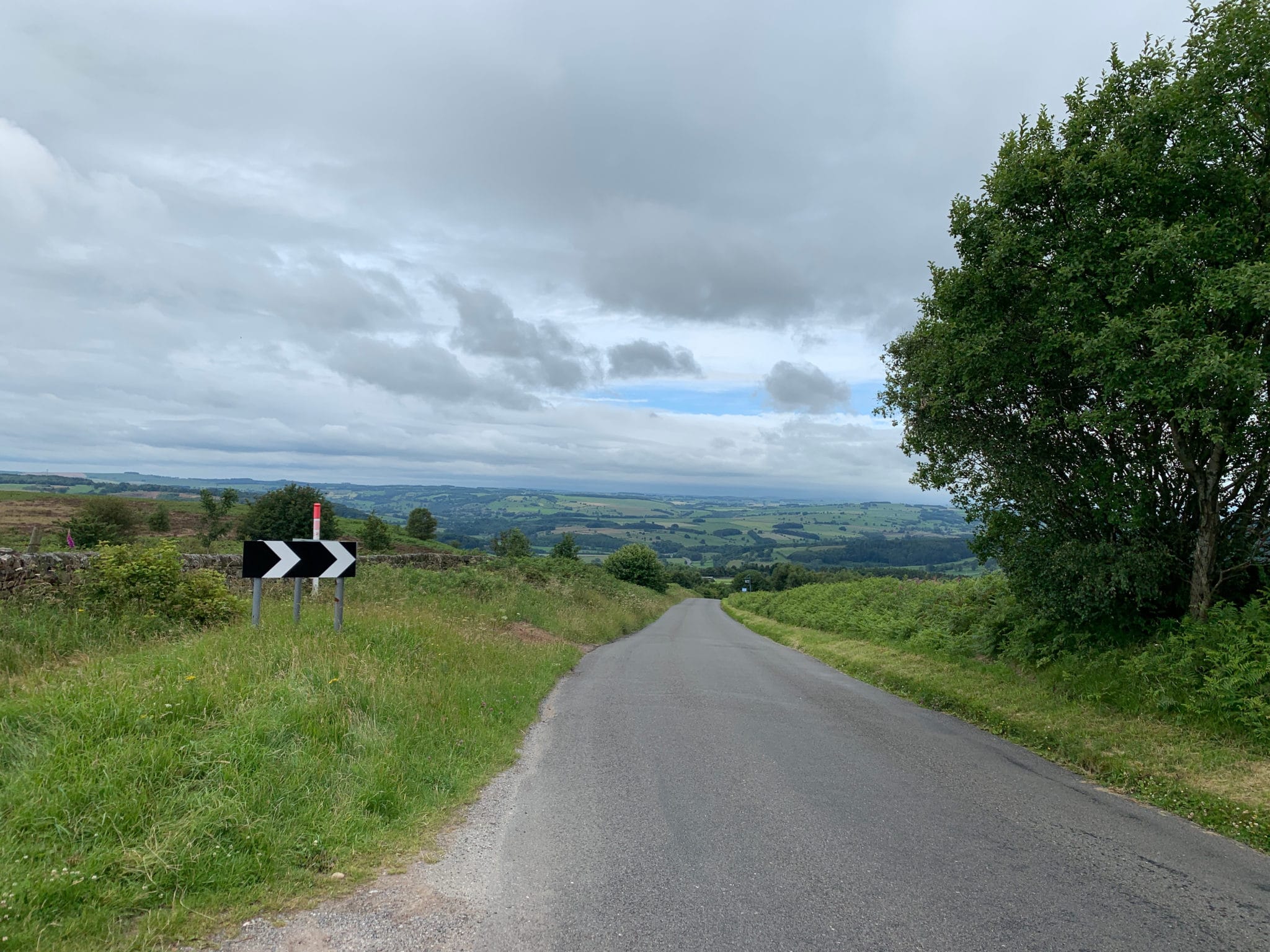
Rowsley Bar
After the revelation of visiting the Peak District last week, I made another stop on the way back from Yorkshire. This time top of my bucket list was Rowsley Bar – the venue of the 1997 National Hill Climb Championship. It is a tough, testing climb; in 1997 Stuart Dangerfield won his fifth title in a time of 5.12, with Jim Henderson in second place. I parked near the summit but saw ‘Road closed’ signs.

Often when roads are closed, you can still cycle through them, but this time it was not possible, so I took two photos and did a u-turn.

After riding up some steep hills in the Peak District I took the opportunity to ride slowly around the Yorkshire Dales on well known routes from Menston to Bolton Abbey. I have never seen so many cyclists on the roads. It is a real boom time for cyclists. I also have never known so many cars on the narrow back road from Bolton Abbey to Ilkley. On the way back I went over Langbar very slowly. It’s a tough climb but the road is quiet.
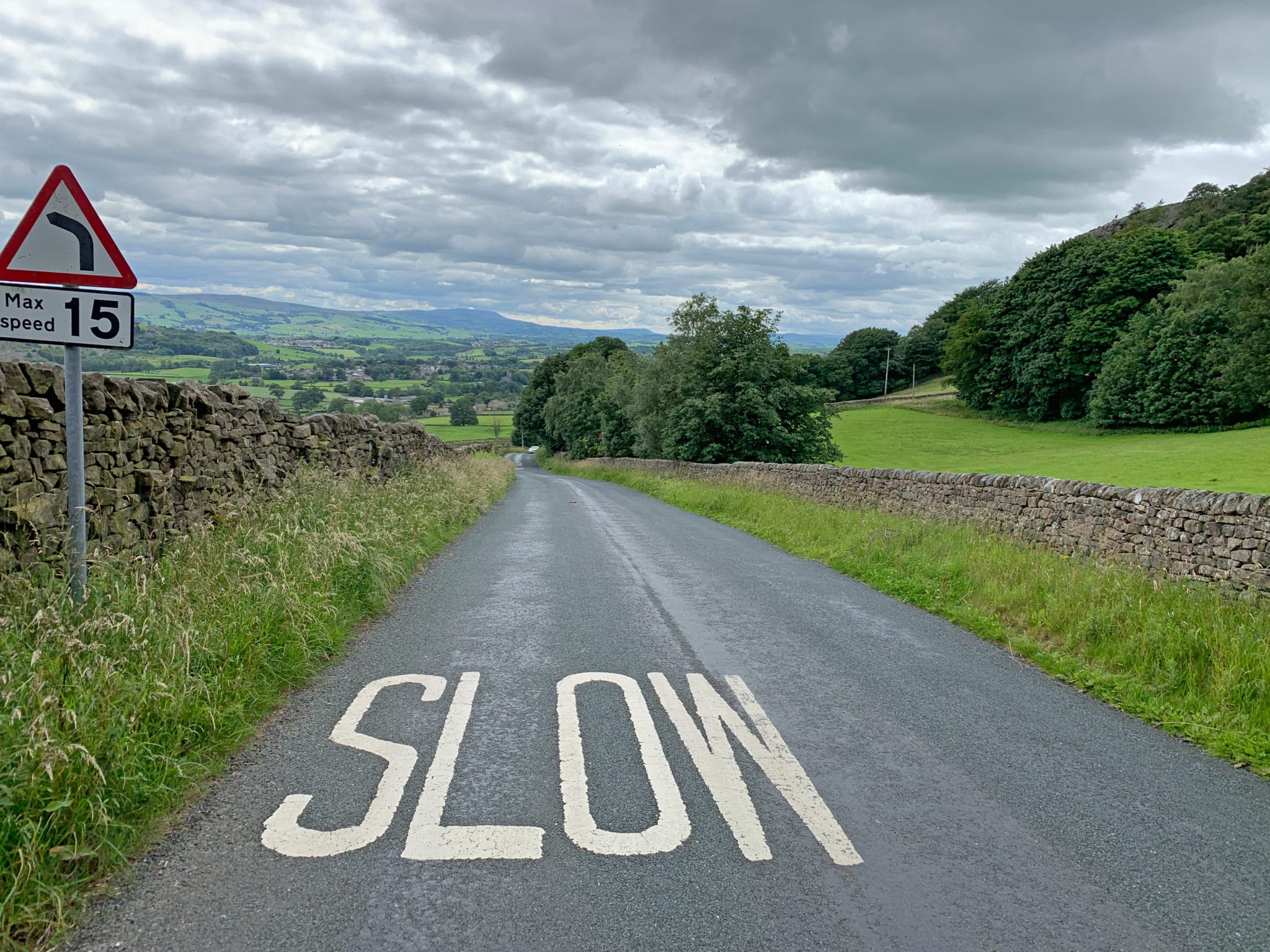
This is a nice climb from Silsden to Embsay Moor. Quite steep and sharp. It’s not such a good descent with these signings warning of max speed of 15mph for the sharp switchback. Time to enjoy the view.
Like most other people the past 3-4 months have been very routine. I have only really left the house to go to the supermarket or cycle rides around the well-known roads of Oxfordshire. It has been a bit of monastic experience, which in many ways suits me fine. But, when you get stuck in the same old routines, you miss out on more spontaneous experiences which are good to refresh the spirits.
Yesterday, I decided it was OK to head north and see my parents for the first time since January. As much as it is good to see the parents, travelling up north often as an ulterior motive to do some cycling there too. This time I thought I would do something different and rather than just the long slog up the M1 would stop off in Matlock and cycle up some hills I had always wanted to do.
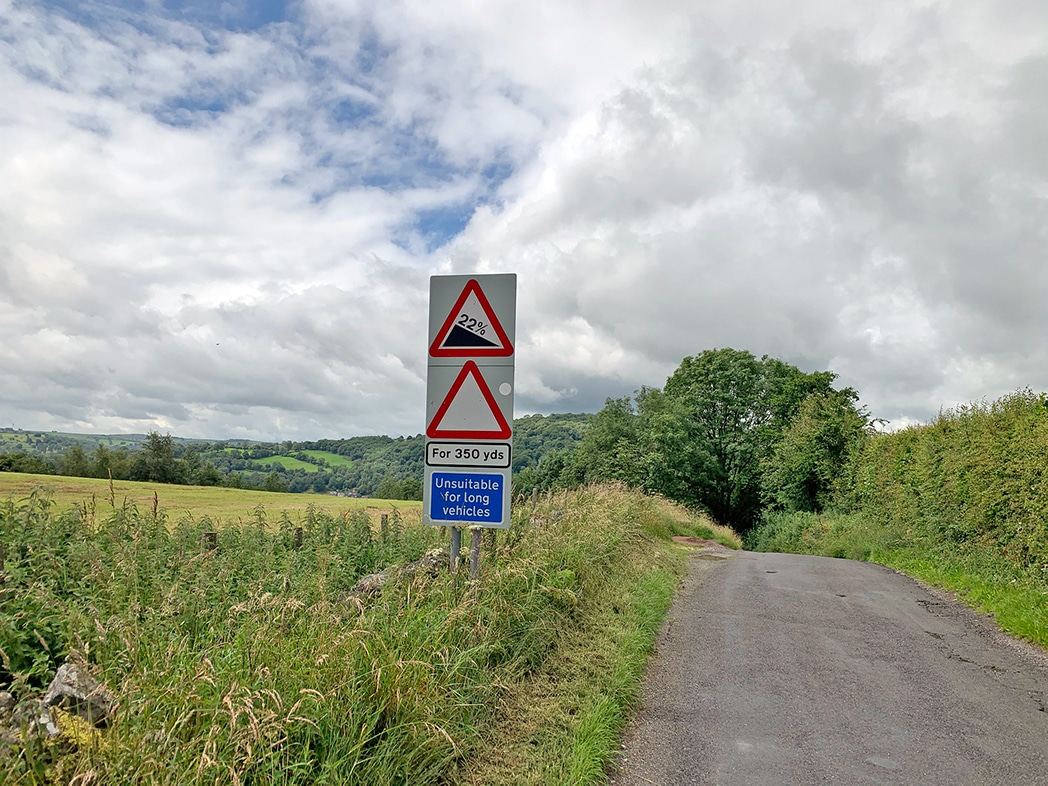
Top of the bucket list was “Riber Hill” I have been meaning to ride Matlock CC Riber hill climb event for many years, but never managed it. It was always on a packed weekend with many other hill climb events. Riber is a great hill climb event and in recent years the course record has been broken quite a few times by some of the top new generation of hill climbers. Riber was the also venue for the national hill climb championship in 1986 when the mercurial Daryl Webster won in a time of 4.48. In 1986, they used the full Riber course – starting closer to Matlock than current hill climb course. The event created some iconic photos – with riders forcing themselves up the steep twisting road, surrounded by large, enthusiastic crowds.
Daryl Webster – 1986 National HC on Riber. Photo by Ian
Yesterday, the road was quite quiet, which is a good job, as you wouldn’t want to meet a van coming down when you’re struggling up Riber. The first section off the A615 takes you through the village of Starkholmes and along Starkholmes Road. There are a couple of ramps and a section of false flat, nothing special, but as you turn left onto Riber Road, the climb gets very interesting and takes on a different complexion.
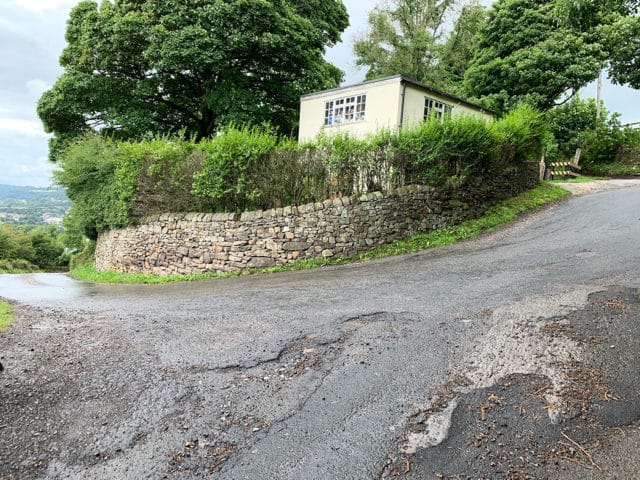
Riber road is sufficiently steep and twisty to look intimidating. There are gradient signs giving a max gradient of 22%, which sounds very accurate, it is probably steeper if you took the direct line. There is no let up in the gradient as you swing left, right, left and then lose track of where you are. The first hairpin was so sharp, I couldn’t maintain full momentum and had to accelerate out of the corner. It is a real technical climb. I kept a fairly decent pace until the last section where I was running out of gas and went down a gear rather than push into the unknown. I think in 100 Climbs, Simon Warren said it was his favourite climb, I can understand why. I like the full version even more than shorter hill climb course. The first section through Starkholmes is testing but is really lulling you into a false sense of security before the main action ahead of you. I love climbs that get harder and harder the more you ride up them. Riber certainly does that.

After Riber, the next climb is within shouting distance. Bank Road, a short 1 km sprint from right in the heart of Matlock town centre. I have only ever ridden this climb in a national championship both in 2008 and 2016. I have never ridden it in training (I guessed rightly that there was no point in trying to perfect my pacing on a climb that was too short for my preference). It was slightly weird to be riding up Bank road without banks of spectators to roar you on.
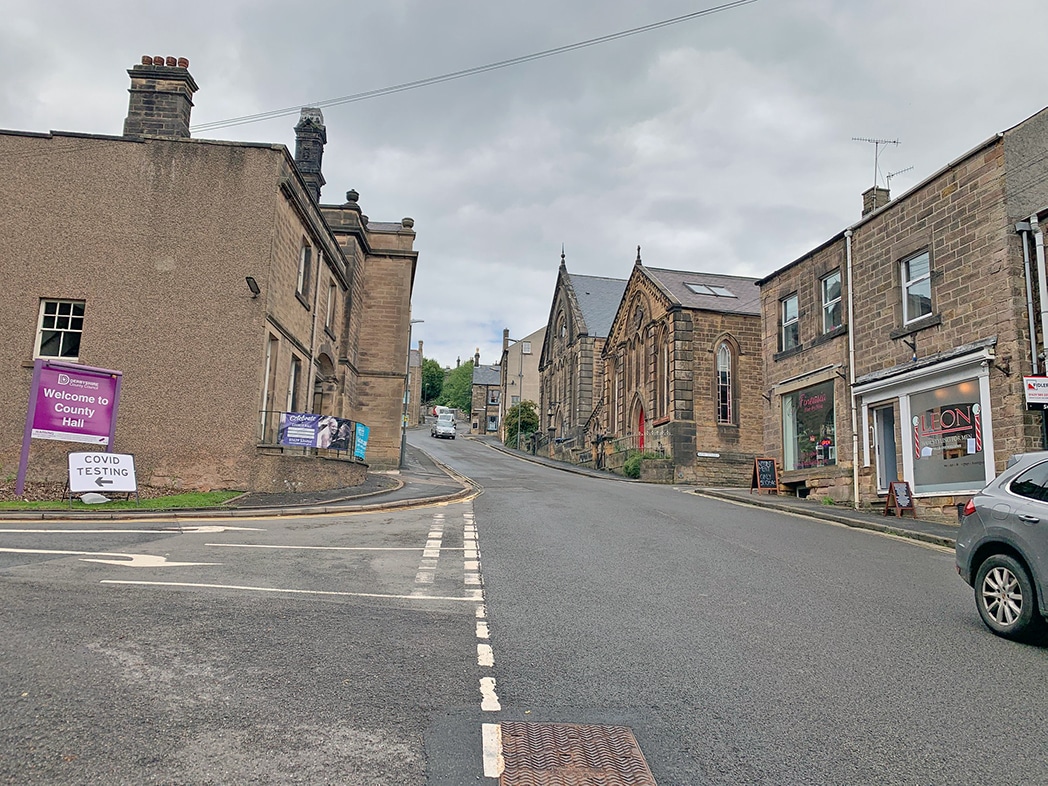
The only thing I saw at the roadside was signs for Covid testing station and signs saying the barber was only by appointment. Welcome to 2020. The first half of the climb I had good pace, but then faded towards the top as the legs were still feeling Riber. Bank Road is really a climb to do when you are as fresh as possible. Still, it was nice to visit Matlock again.
After that, I went to Slack hill – only a few miles away.
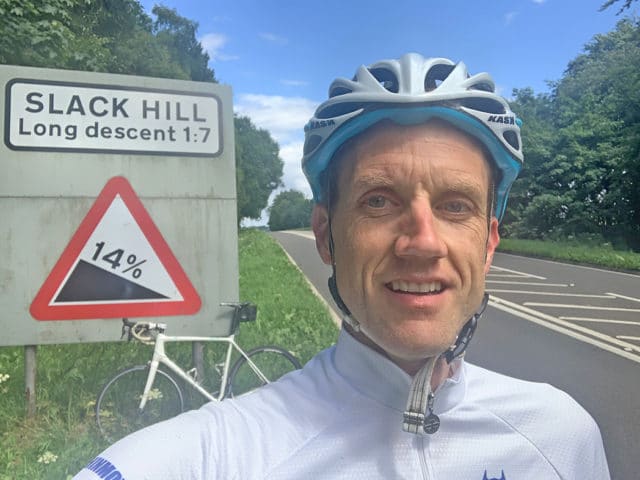
After the drama of Riber and Bank Road, Slack Hill is not in the same league. It is fairly straight and unrelenting 14% gradient. It is a fairly busy A road so you get a little help from passing traffic. The best thing about the climb is that you can pick up speed coming down from Kestleridge and you can start the climb with a good 30mph on the bike. However, this speed soon evaporates very fast and you are left pushing up the hill. I’m sure I would feel more inclined to the hill if I didn’t have a headwind and tired legs, but it was still a decent pace. Near the top, I also saw a sign to Beeley Moor. Are there no end to good climbs in this part of the world?
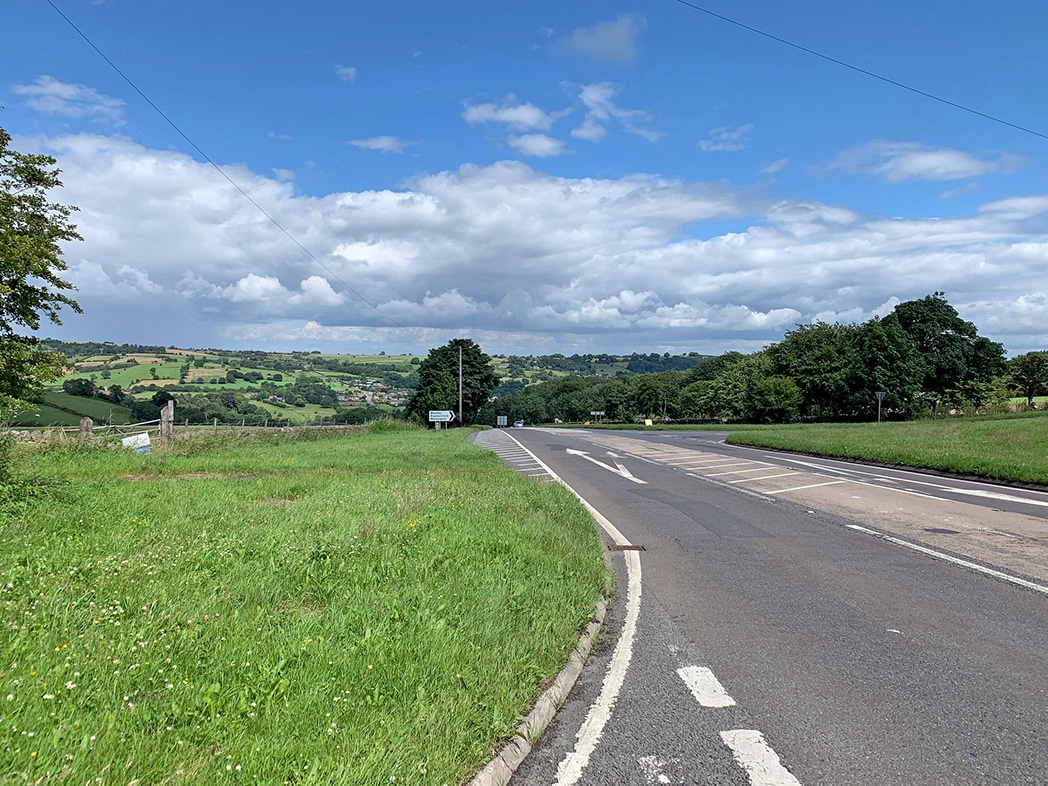
In an ideal world, a cycling visit to Matlock would involve six hours, 100 miles and 20+ climbs, but although I am getting in better shape, I still get aches and pains from the troublesome hip and back. That is why I limited my ride to a measly 12 miles. But what a 12 miles it was. I got a real buzz from racing up Riber and Bank Road. Although I’m disappointed not to make a full recovery, the rest of the body seems in quite good shape and despite limited training (by my standards of training) I can still get up hills pretty well.
In the end, it took all day to get from Oxford to Menston, but it was a really good experience to do something different and get out of the daily routine. It was really liberating to be at the top of a steep hill.
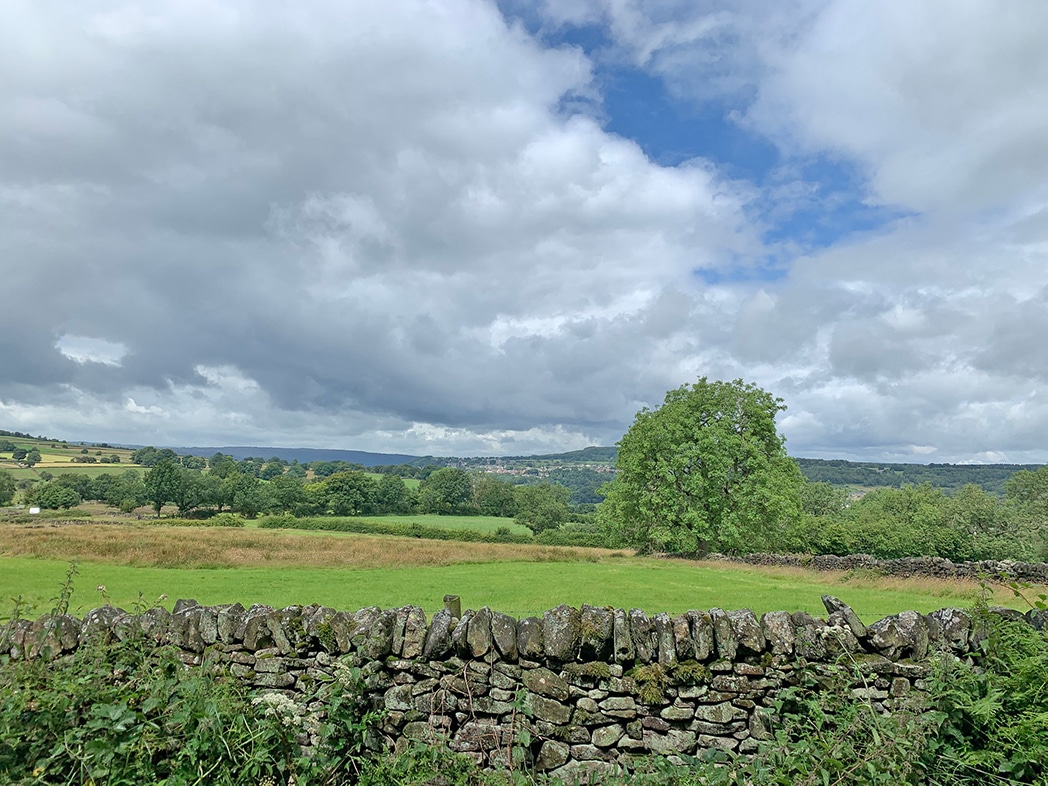
I enjoyed everything about it. Driving through the Peak District, the view from the tops of hills, but mostly the exhilaration of racing up Riber bends.
Simon Warren has a list of 200 climbs, where you can vote for favourite UK hill climbs based on 100 Climbs series.
My favourite climbs depend on the personal experience of riding them. So they are blurred by the direction of the wind, weather conditions and whether I was in good shape. Also, doing a hill climb event gives a very different experience to just riding during training. If I had to choose my top 10, they would be nearly all hill climb courses, apart from Hardknott and Great Dun Fell. Winnat’s Pass is currently number one. I’ve only ridden it once after doing a hill climb event on Long Hill. I can’t really remember much about it – which is a shame because it is a beautiful climb.
These are some of my favourites that spring to mind.
Great Dun Fell
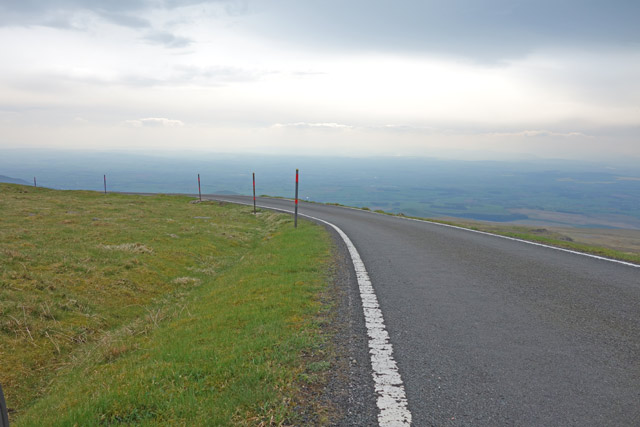
If I could choose to have one climb on my doorstep it would be Great Dun Fell. The statistics make it by far the climb of almost vertical ascent. It’s not just long, but really steep and on a good day has great views over the Pennines. Even better it is relatively car-free – being well off the beaten track. The only downside is its relative inaccessibility and how sometimes the gates are closed meaning you have to get off the bike and open and close gates. I think I have visited the climb three times – each occasion was after doing a hill climb event up Shap Fell. (giving me two climbs for the price of one so to speak)
Hardknott pass
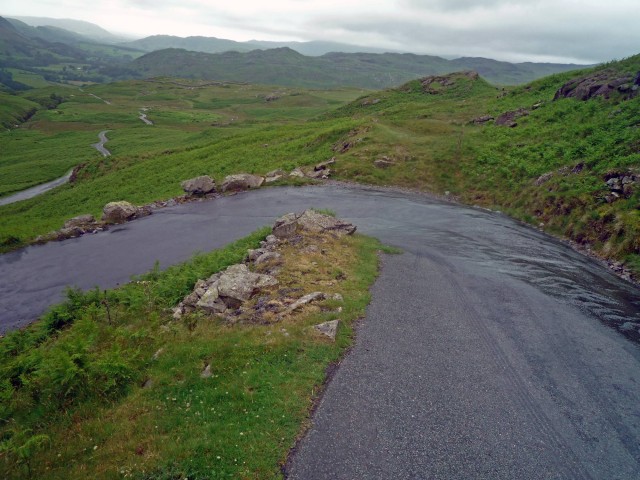
Hardknott is super steep. Sometimes, you see a 30% gradient sign, but they don’t really mean it. Hardknott is really that steep in both directions. Hardknott is so steep you are wondering if you are going to make it to the top. The first time I went up Hardknott I had a lot of miles and climbs in my legs and it was a real grovel hunched over the drops, you don’t forget experiences like that. On the really steep section, I also got the experience that I felt like I was falling over backwards- Brilliant!
The Struggle
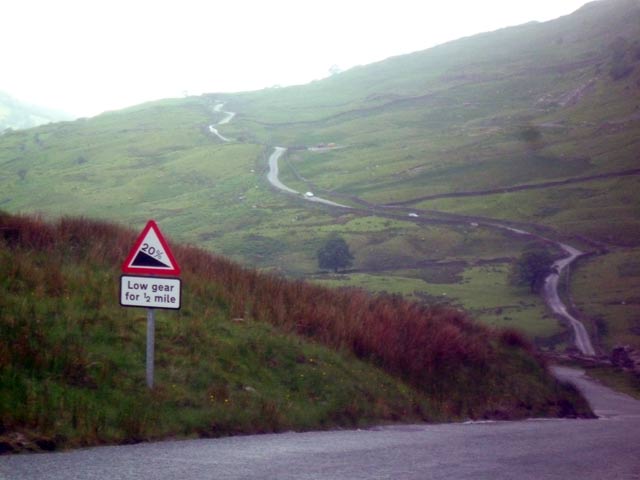
One of three ways up Kirkstone Pass, the Struggle is the steepest. Out of Ambleside, it is very steep up smooth winding road, before a long drag up to the top. At the top, make sure you look back to Lake Windermere, it is quite spectacular views. I have one memorable experience of cycling up the Struggle. I had cycled over 100 miles around the Lake District (and some big climbs). I got to Ambleside was really tired and stopped to have a piece of Kendle Mint Cake and seemed to get a second wind which enabled me to cycle up The Struggle quite quick. It was a great day in the Lakes.
Shibden Wall
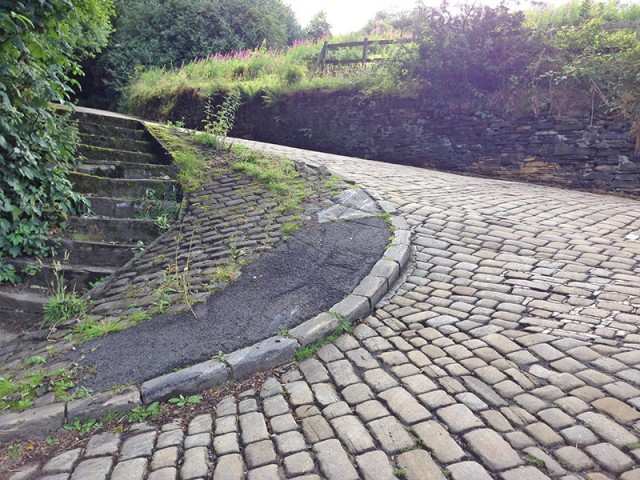
A slightly harder cobbled climb is Thwaites Brow in Keighley. But, the cobbles are in a bad state of repair, with really big gaps between them. It was too much trying to get traction on those big cobbles. Shibden Wall is a great cobbled climb. It starts off on tarmac then graduates into cobbles. There is a wicked left-hander and it is pretty steep. Off the beaten track near Halifax, but quite close to my parent’s house.
Pea Royd Lane

I wouldn’t usually choose Pea Royd Lane, it’s a little on the short side for my liking. But, I’ve grown to love the climb after racing up it so many times. I’ve done it twice in the national hill climb championship 14th and 4th, and in 2014, and I rode it several times in training. In many ways, it is a classic British hill climb. Steep, undulating, and a couple of corners. At the top, it is a great view of Stocksbridge below. In 2014, despite disappointment at 4th, I had a good experience on the climb and it is that perfect length and difficulty to wring everything out of you, leaving you exhausted at the top.
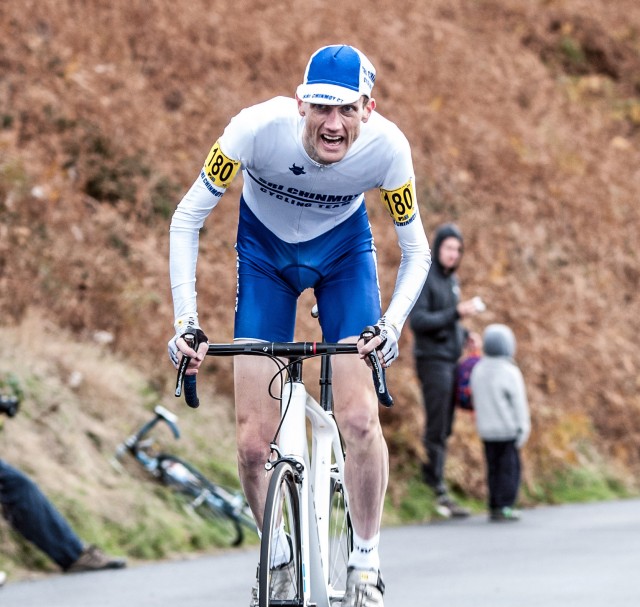
Greenhow Hill
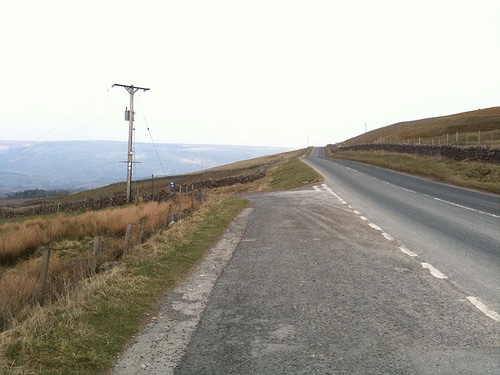
Greenhow Hill was the first big hill I ever cycled up. It was in the days before I was a cyclist. I was about 14 and I went on camping holiday with a friend. We took mountain bikes. The main thing I remember is that my friend had to get off and walk, but I could cycle to the top and then go back down whilst waiting for him. Poor chap wasn’t built for hill climbs! But, it is a great climb because there are four ‘ridges’ steep sections of 17%, then a section to recover. The last grovel to the summit can be a pain if it is windy, but it is an atmospheric climb and I love the views from the top.
Porlock
There are two ways up Porlock, the very steep way or the long, steady gradient of the toll road. Minehead CC organise a hill climb event up the Toll Road, which I have done three times. This is a beautiful climb. The 100 climbs version is the steep hill out of the town centre. It starts off with a few 25% corners and is really tough. I have only done this version after racing up the toll road. But, it is a great climb. It was always a good experience going down to Porlock.
Norwood Edge
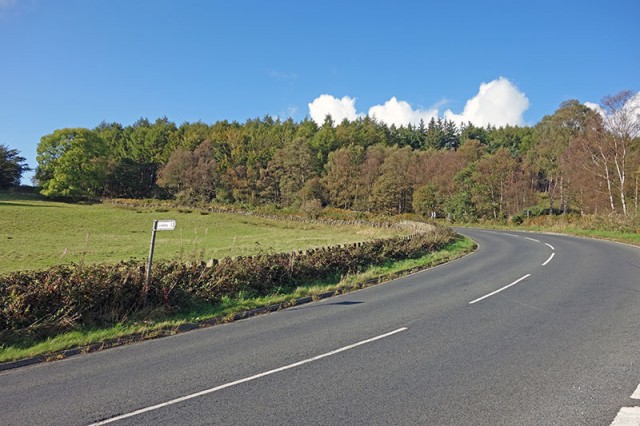
Norwood Edge was my first hill climb event in 1994! I don’t think I knew what I was letting myself in for. My main memory is that it took about two days to take off mudguards from my Reynolds 501 Ellis Briggs 10 speed racing bike and then about two weeks to put the mudguards back on. I was nearly last anyway so I might as well have left them on. But, in those days, it seemed a great achievement to get up the hill at all, let alone race really quick. In 2011, I got within four seconds of Jeff Wright’s famous course record, setting a time of 4.46, I was really flying that year. Since then the climb seems to get harder every year!
The Stang

The first time I went up the Stang it was a block headwind and I didn’t particularly enjoy this long drag into the bleak North Yorkshire Moors. But, on the big day in October 2013, there was a raging tailwind making it an unbelievable climb. Really steep first section, then a bit of fast downhill (39 mph!) on the big ring and then the final long drag. The Stang is a bit out of the way, up in North Yorkshire, but it is definitely worth a visit. Ironically I haven’t been back since 2013. Perhaps it is because I know I will never get close to the course record of 7.57 ever again. Proving the emotional connection of hills, seeing a picture of the race bring back many good memories.
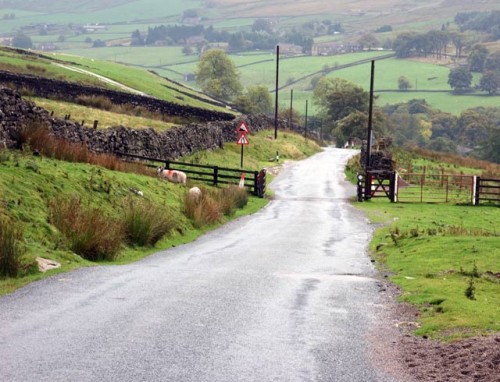
Other climbs to give honourable mention to

I have done the Bristol South CC event nine times and finished 1st on seven times. It was one of the first hill climbs I did in 2004 and realised I might be quite good. But, I love the atmosphere of the race, the beautiful scenery and the chat in the cafe afterwards. You can get into a good rhythm on the steady slopes
Other memorable climbs